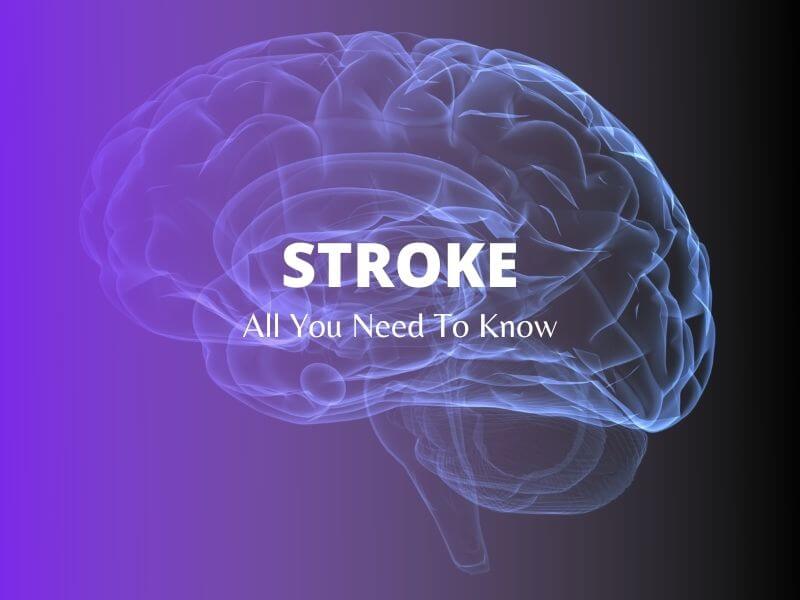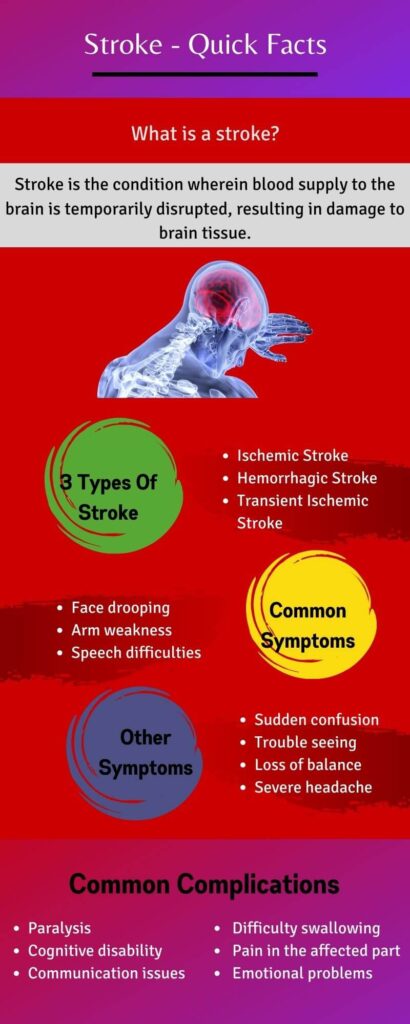At A Glance: The focus of this article is to briefly describe about the condition Stroke which tends to be one of the leading causes of disability and death worldwide, the prominent symptoms, risk factors, and the treatment.
What is a stroke?
Stroke is the condition wherein blood supply to the brain is temporarily disrupted, resulting in damage to brain tissue.
Since the brain is a complex organ that controls numerous bodily functions, when a particular part of the brain does not receive blood, it affects the respective functions.
For example, if the stroke occurs to the back of the brain (occipital lobe), it affects the vision. Similarly, stroke can impact any number of other functions such as,
- speech
- muscle movement
- cognitive abilities
depending on which part of the brain is affected.
Further, the extent of the resulting disability depends on the extent of brain cell damage.
Types of stroke:
There are three main types of stroke.
- 1. Ischemic stroke: Is the one when a stroke occurs due to a blood clot that affects the flow of blood to the brain.
- 2. Hemorrhagic stroke: A hemorrhagic stroke is a scenario wherein a blood vessel ruptures, thereby preventing blood flow to the brain.
In both the above cases, the symptoms typically last more than 24 hours and may not resolve completely with treatment.
- 3. Transient Ischemic Attack: A Transient Ischemic Attack(T.I.A.) also known as a “mini-stroke“, is caused by a temporary clot. Though the T.I.A. symptoms resolve within 24 hours, it needs to be considered as a sign of future stroke and needs treatment as there is a high chance of another stroke within the next few weeks.
Symptoms
Since the brain cells begin to die within minutes of having a stroke, it is essential to seek medical attention immediately. So, to know if it is a stroke, you need to know the symptoms.
1. Common Symptoms:
Here is an easy way to remember the most common symptoms:
Remember this acronym: F.A.S.T.
- F – Face drooping
- A – Arm weakness
- S – Slurred speech
- T – Time
When someone has one or more symptoms of Face drooping, Arm weakness, and Speech difficulties, it is Time to call emergency services.
2. Other Symptoms:
Some of the other prominent symptoms include sudden confusion, trouble seeing, loss of balance, and severe headache that could be associated with no known cause. One can feel the warning signs hours or even days before the attack.
3. Silent Stroke With No Symptoms:
You could also have a stroke and not know it; it is known as a Silent stroke. As the name implies, no symptoms would be felt as the damage would have occurred to those parts of the brain that does not control any noticeable functions such as vision or speech. Such silent strokes are only detected with C.T. or M.R.I. scan is done for some other condition.
Also Read:
- Bacopa Monnieri (Brahmi) – The Herb With Remarkable Medicinal Benefits
- 10 Lifestyle And Diet Tips To Manage Fibromyalgia Naturally
Risk factors

The factors that can increase the risk of stroke are:
- Controllable:
Lifestyle factors such as unhealthy diet, inactivity, too much alcohol consumption, smoking, drug abuse can increase stroke risk.
- Uncontrollable:
Certain other factors such as genetics, age, race and sex, which are not under our control can also contribute to stroke risk. Those who are over 55 years, African Americans, and men in general fall into this category.
- Medical factors:
And, medical issues such as high blood pressure, diabetes, high cholesterol influence stroke risk.
Impact of stroke
Though stroke is one of the leading causes of death, not all strokes are fatal. In fact, Timely treatment can considerably improve the chances of survival. But, having a stroke can result in a disability that might be temporary or permanent, depending on how long the brain is deprived of blood flow and the part affected.
Some of the common complications of stroke include,
- Paralysis: One side of the body might completely paralysed; Or the paralysis might be partial resulting in loss of control on few muscles on one side of the body
- Cognitive disability: Memory loss, difficulty in thinking, understanding, reasoning, and making decisions are some of the cognitive impairments that can occur.
- Communication issues: Difficulty with language processing, reading, writing and speaking might be affected.
- Difficulty swallowing: When the stroke affects the mouth and throat muscles, it might cause difficulty to eat. This is the reason for the communication problems too.
- Pain: Unusual pain or numbness in the affected part is common with stroke patients.
- Emotional problems: Since stroke can impact daily life to a significant extent due to the resulting disabilities, emotional health can be affected considerably.
Also Read: Living With Gratitude Leads You To Happiness
Treatment
Since the severity of stroke impact is directly correlated with prompt treatment, the emergency team gets to work immediately upon reaching the emergency ward.
The doctors would conduct tests to determine the type of stroke and also to rule out any other reason for the symptoms to proceed with the apt treatment procedure which might include medication, surgery and other endovascular procedures.
Once the situation is stable, then the focus would shift to prevent future strokes and planning the rehabilitation.
Steps To Prevent Future Strokes
One in four stroke survivors tends to have another stroke within the next five years unless the underlying cause is addressed. Hence, the doctor will prescribe medications and lifestyle changes to treat the cause, which might be diabetes, or high blood pressure or high cholesterol, or atrial fibrillation, etc.
Recovery process:
The road to recovery could be a long one in case of a stroke. While some patients might recover completely, some do partially, and others might not recover completely. so, the goal is to relearn the lost skills to become independent and lead a life as close to normal as possible.
As no two strokes are the same, the rehabilitation program could include :
- Physical therapy
- Speech therapy
- Occupational therapy
and more…
The rehabilitation exercise will typically start during the hospital stay as soon as the situation is past life-threatening stage. Rehabilitation will continue after leaving the hospital in various other settings such as a special rehabilitation ward or a long-term care facility, complemented by home-based therapy.
Adhering to the prescribed routines in terms of lifestyle and therapies can significantly improve the quality of life in stroke survivors.
Interesting fact: Though the permanent damage to the brain cells due to stroke may not be reversed, other healthy parts of the brain might take over the functions performed by the damaged area.
Note:
It is best to call the emergency services and avail ambulance service immediately rather than driving down to the emergency room. This is because the medical staff in the ambulance will start life-saving treatment even before reaching the emergency room.
Images from canva.com
We hope the article has given you an insight into Stroke, symptoms, causes, and treatment. If you would like to further test your knowledge on Stroke, here is a little quiz.
Share This Post:

